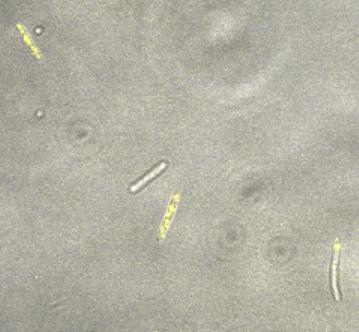Virginia Tech/phage lysate
From 2007.igem.org
|
|
ATCC λ PropagationWe purchased wild type (WT) lambda phage from the American Type Culture Collection (ATCC) in the form of a freeze dried lysate. The phage was labeled as ATCC 23724-B2. We also purchased a lambda negative strain of E. coli (C600, or ATCC 23724). In order to propagate this phage, we prepared an overnight culture of C600. We used the overnight culture to produce plates with top agar bacterial lawns and liquid cultures. We soon discovered that it was more difficult to work with liquid cultures than bacterial lawns when the titer of the phage was unknown. We used phage plaques to produce high titer lysates in the realm of 10^9-10^11 plaque forming units per milliliter (pfu/mL). When working with phage in liquid cultures, we discovered that the amount of phage added and the density of the cell culture were very important. As the multiplicity of infection (MOI) increases, so does the likelihood of lysogeny. A lower MOI typically drives the phage to the lytic pathway. Phage propagation is also more likely to occur, through lysis or lysogeny, if the cell culture is less dense. We made these observations in the lab, but they are also published by a number of different sources. The experience we gained working with phage was very helpful when testing the single population infection model. λ-EYFP PropagationPhilippe Thomen provided the fluorescent phage as a lysogen in NM538 E. coli. The Alvarez paper, "Propagation of fluorescent viruses in growing plaques" describes the phage as having a thermo-sensative mutation in the genes that regulate cI, so we grew a culture to an OD600 of 0.1 at 30°C and then subjected it to heat shock at 42°C for 15 minutes. This effectively destabilized the cI protein, and drove the lysogens to lysis. Within 45 minutes at 37oC and good aeration, the cells had lysed and the culture was clear. We recovered the phage by adding 0.1 mL of chloroform to the cultures, spinning down the cell debris, and collecting the supernatant. Serial dilutions of the lysates were used to produce plaques of phage on top agar bacterial lawns. These plaques were used to generate high titer lysates of λ-EYFP in the order of 10^9-10^11 pfu/mL. The lysates were important for experiments determining bacteria-phage interactions as well as infections of populations of bacteria.
|







